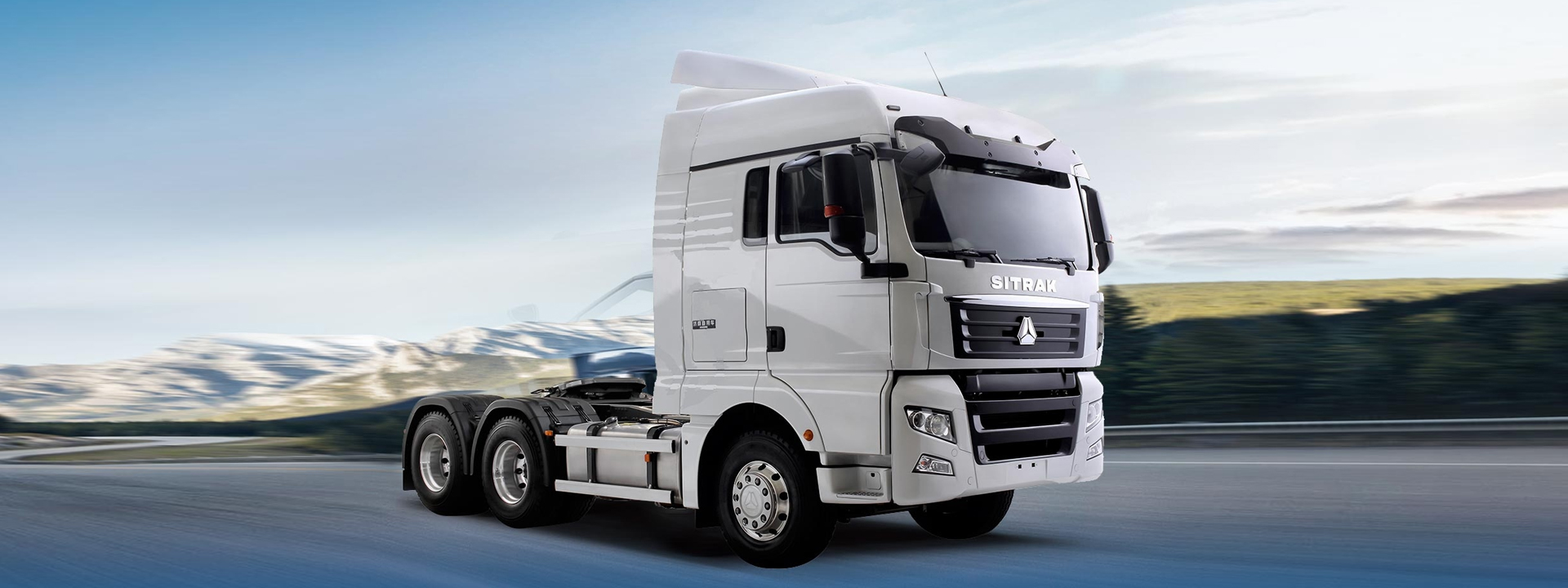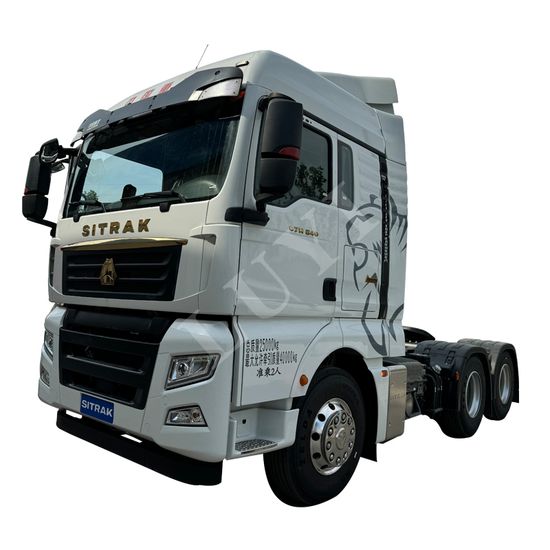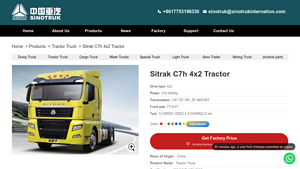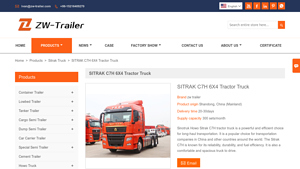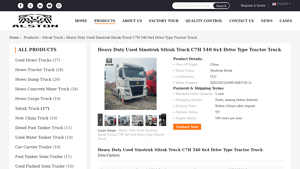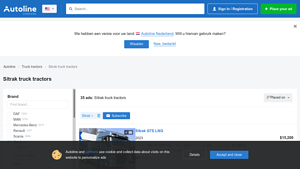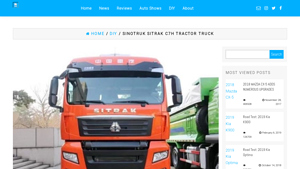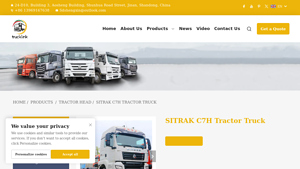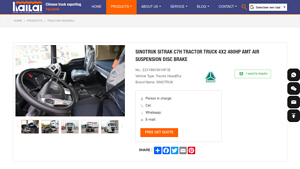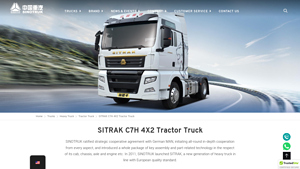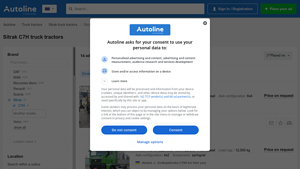Introduction: Navigating the Global Market for sitrak C7h Tractor Truck
In the competitive landscape of global logistics, sourcing reliable heavy-duty vehicles like the Sitrak C7H Tractor Truck poses significant challenges for international B2B buyers. With rising fuel costs and stringent emission regulations, organizations must prioritize efficiency and durability when selecting their fleet. This guide serves as a comprehensive resource for understanding the Sitrak C7H, covering its various configurations, applications in different sectors, and critical factors such as supplier vetting and cost considerations.
Designed to empower decision-makers from regions including Africa, South America, the Middle East, and Europe, this guide offers actionable insights that simplify the procurement process. By addressing the unique demands of diverse markets—such as robust performance requirements in Nigeria’s challenging terrains or cost-efficiency for operations in Vietnam—this resource equips buyers with the knowledge to make informed purchasing decisions.
Moreover, we delve into the latest advancements in Sitrak technology, ensuring you stay ahead of the curve in a rapidly evolving industry. With an emphasis on quality, reliability, and cost-effectiveness, our guide is tailored to enhance your sourcing strategy, ultimately contributing to the operational success of your logistics and transportation endeavors.
Understanding sitrak C7h Tractor Truck Types and Variations
| Type Name | Key Distinguishing Features | Primary B2B Applications | Brief Pros & Cons for Buyers |
|---|---|---|---|
| Sitrak C7H 4×2 Tractor | 4×2 drive, power range 310-540HP, various axle options | Short to medium-haul transport | Pros: Cost-effective, versatile; Cons: Limited off-road capability. |
| Sitrak C7H 6×4 Tractor | 6×4 drive, high torque (2,000 Nm), Euro 5 compliant | Long-haul freight and logistics | Pros: Excellent fuel efficiency, high payload; Cons: Higher initial cost. |
| Sitrak C7H LNG/CNG Tractor | 6×4 configuration, powered by LNG/CNG, 540HP | Eco-friendly transportation | Pros: Reduced emissions, lower fuel costs; Cons: Availability of refueling stations may be limited. |
| Sitrak C7H Heavy Duty Tractor | Robust design, heavy-duty suspension, high load capacity | Heavy-duty logistics, construction | Pros: Durable, suitable for rough terrains; Cons: Heavier, potentially higher maintenance costs. |
| Sitrak C7H Customizable Tractor | On-demand customization options for various needs | Specialized transport services | Pros: Tailored solutions, meets specific operational requirements; Cons: Longer lead time for delivery. |
What Are the Key Characteristics of the Sitrak C7H 4×2 Tractor Truck?
The Sitrak C7H 4×2 Tractor Truck is designed for short to medium-haul transportation. It features a versatile drive system, offering a power range between 310-540HP, which is suitable for various cargo types. Its axle configurations allow for adaptability in different loading scenarios, making it a popular choice among logistics companies looking for cost-effective solutions. Buyers should consider its limited off-road capability when planning operations in rugged terrains.
How Does the Sitrak C7H 6×4 Tractor Truck Stand Out?
The Sitrak C7H 6×4 Tractor Truck is tailored for long-haul freight and logistics operations. With a robust engine that delivers high torque and Euro 5 compliance, it ensures efficient fuel consumption and reduced environmental impact. This model is ideal for businesses focused on heavy freight transport, providing excellent payload capacity. However, its higher initial investment may be a consideration for budget-conscious buyers.
Why Choose the Sitrak C7H LNG/CNG Tractor Truck?
For companies prioritizing eco-friendly transportation, the Sitrak C7H LNG/CNG Tractor Truck is a standout option. This model utilizes alternative fuel sources, resulting in lower emissions and reduced fuel costs. It is particularly suitable for urban logistics and companies looking to enhance their sustainability efforts. However, potential buyers should assess the availability of LNG/CNG refueling stations in their operational areas.
What Advantages Does the Sitrak C7H Heavy Duty Tractor Offer?
The Sitrak C7H Heavy Duty Tractor is engineered for robust performance in demanding environments. It features a heavy-duty suspension system and high load capacity, making it suitable for logistics in construction and mining sectors. Its durability is a significant advantage for businesses that require reliable vehicles for challenging operations. Buyers should be mindful of the potentially higher maintenance costs associated with such heavy-duty models.
How Does Customization Benefit Sitrak C7H Tractor Truck Buyers?
The Sitrak C7H Customizable Tractor Truck offers on-demand customization options, allowing buyers to tailor specifications to their operational needs. This flexibility makes it an excellent choice for specialized transport services that require unique configurations. While customization ensures that trucks meet specific requirements, buyers should consider the longer lead time for delivery and potential increases in cost.
Key Industrial Applications of sitrak C7h Tractor Truck
| Industry/Sector | Specific Application of sitrak C7h Tractor Truck | Value/Benefit for the Business | Key Sourcing Considerations for this Application |
|---|---|---|---|
| Logistics and Transportation | Long-haul freight transportation | Enhanced fuel efficiency and reduced operational costs | Evaluate fuel consumption rates and maintenance support availability |
| Construction | Heavy equipment transport | Reliable and robust design for transporting construction machinery | Assess payload capacity and compatibility with specific equipment |
| Agriculture | Transporting agricultural products | Quick and efficient distribution of perishable goods | Consider temperature control options and load securing capabilities |
| Mining | Hauling minerals and raw materials | Increased durability and performance in rugged terrains | Investigate axle load ratings and off-road capabilities |
| Oil and Gas | Transportation of drilling equipment | High power output for heavy loads and challenging environments | Ensure compliance with regional regulations and safety standards |
How is the Sitrak C7h Tractor Truck Used in Logistics and Transportation?
In the logistics sector, the Sitrak C7h Tractor Truck is primarily utilized for long-haul freight transportation. Its powerful engine options and fuel efficiency significantly reduce operational costs, making it a preferred choice for transportation companies. For international buyers, especially in regions like Africa and South America, it is crucial to assess the truck’s fuel consumption rates and the availability of maintenance support to ensure reliability over long distances.
What Role Does the Sitrak C7h Play in Construction?
The Sitrak C7h Tractor Truck is also vital in the construction industry, where it transports heavy equipment and materials to job sites. Its robust design and high payload capacity allow it to handle the rigorous demands of transporting construction machinery. Buyers in this sector should consider the truck’s compatibility with specific equipment and its ability to navigate diverse terrains, particularly in emerging markets where road conditions may vary.
How is the Sitrak C7h Beneficial for Agriculture?
In agriculture, the Sitrak C7h is employed to transport agricultural products, ensuring timely delivery of perishable goods. Its fuel efficiency and spacious cargo capacity enhance productivity for agricultural businesses. For B2B buyers, it is essential to evaluate the truck’s load securing capabilities and any available temperature control options, especially for regions with extreme weather conditions.
Why is the Sitrak C7h Ideal for Mining Operations?
The mining industry relies on the Sitrak C7h Tractor Truck for hauling minerals and raw materials from extraction sites. The truck’s durability and performance in rugged terrains make it a dependable choice for mining operations. Buyers should investigate the axle load ratings and off-road capabilities to ensure that the truck meets the heavy demands of the mining sector, particularly in remote areas.
How Does the Sitrak C7h Support Oil and Gas Transportation?
In the oil and gas sector, the Sitrak C7h is used for transporting drilling equipment and materials to remote sites. Its high power output is crucial for carrying heavy loads under challenging conditions. International buyers must ensure that the truck complies with regional regulations and safety standards, which can vary significantly across different countries, particularly in the Middle East and Africa.
3 Common User Pain Points for ‘sitrak C7h Tractor Truck’ & Their Solutions
Scenario 1: Navigating Fuel Efficiency Concerns in Long-Haul Operations
The Problem: One of the significant challenges faced by transportation companies using the Sitrak C7H Tractor Truck is managing fuel consumption, especially during long-haul operations. Companies in regions like Africa and South America often operate in diverse terrains, which can lead to increased fuel usage. High fuel costs can severely impact profit margins, making it essential for businesses to optimize fuel efficiency without compromising on performance.
The Solution: To effectively address fuel efficiency concerns, buyers should consider the following strategies when sourcing and operating the Sitrak C7H. First, choose the appropriate engine configuration that best matches your operational needs. The Sitrak C7H offers various power outputs (310-540Hp) and transmission options (10F, 12F, 16F), enabling operators to select the best fit for their typical load and route conditions.
Additionally, ensure that regular maintenance is performed according to the manufacturer’s guidelines, focusing on the fuel system, air filters, and tires, as these can greatly affect fuel consumption. Implementing driver training programs that emphasize fuel-efficient driving habits—such as maintaining steady speeds and reducing idling time—can further enhance fuel savings. Lastly, leverage telematics systems to monitor fuel usage in real-time, identifying patterns and areas for improvement.
Scenario 2: Addressing Reliability Issues in Harsh Operating Environments
The Problem: Transportation companies in regions with extreme weather conditions or rugged terrains often face reliability issues with their trucks. For instance, the Sitrak C7H, while known for its durability, can still encounter challenges in harsh climates, such as excessive heat or heavy rainfall, which can lead to mechanical failures or downtime. This unreliability can disrupt logistics and lead to financial losses.
The Solution: To mitigate reliability issues, buyers should focus on customizing their Sitrak C7H Tractor Trucks to better withstand local conditions. Consider options such as enhanced cooling systems or weatherproofing features that protect vital components from moisture and dirt ingress. Additionally, investing in high-quality spare parts, specifically designed for extreme conditions, can significantly improve the truck’s longevity and reliability.
Regularly scheduled maintenance checks are crucial; make sure to inspect critical systems like the cooling system, brakes, and suspension more frequently if operating in severe conditions. Establishing a partnership with a reliable local service provider for rapid maintenance and repairs can further enhance operational reliability, minimizing potential downtime.
Scenario 3: Managing the Complexity of Importing Heavy Machinery
The Problem: B2B buyers, particularly in developing markets, often struggle with the complexities of importing heavy machinery like the Sitrak C7H. Issues such as customs regulations, logistics challenges, and language barriers can complicate the procurement process, leading to delays and unexpected costs that can disrupt business operations.
The Solution: To streamline the import process, businesses should engage with experienced logistics partners who specialize in heavy machinery transport. These partners can provide valuable insights into local customs regulations and help navigate the paperwork required for importing the Sitrak C7H.
Buyers should also consider establishing clear communication channels with suppliers to clarify all terms of purchase, including payment methods (L/C, T/T) and delivery timelines. It’s advisable to conduct thorough research on shipping methods, such as Ro-Ro or bulk shipping, to determine the most cost-effective option. Additionally, investing time in understanding the supply chain logistics can help anticipate potential delays, allowing for better planning and reducing the impact on operational schedules.
Strategic Material Selection Guide for sitrak C7h Tractor Truck
What Are the Key Materials Used in the Sitrak C7h Tractor Truck?
The Sitrak C7h Tractor Truck employs a variety of materials that enhance its performance, durability, and efficiency in demanding transport conditions. Understanding these materials is crucial for international B2B buyers, particularly those from regions like Africa, South America, the Middle East, and Europe, where environmental conditions and operational requirements can vary significantly.
How Does Steel Contribute to the Performance of the Sitrak C7h Tractor Truck?
Steel is a primary material used in the construction of the Sitrak C7h, particularly in its chassis and structural components.
- Key Properties: Steel offers high tensile strength and excellent durability, making it suitable for heavy loads and rough terrain. It can withstand high temperatures and pressures, which is essential for long-haul operations.
- Pros & Cons: While steel is relatively low-cost and widely available, it can be prone to corrosion if not properly treated. The manufacturing process can be complex, especially for specialized components.
- Impact on Application: Steel’s strength makes it ideal for supporting heavy cargo, while its weight can affect fuel efficiency. Buyers should consider the balance between strength and weight for optimal performance.
- Considerations for International Buyers: Compliance with international standards such as ASTM and DIN is essential. Buyers in regions with high humidity or saline environments should prioritize corrosion-resistant treatments.
What Role Does Aluminum Play in the Sitrak C7h Tractor Truck?
Aluminum is increasingly used in various components of the Sitrak C7h, particularly in areas where weight reduction is crucial.
- Key Properties: Aluminum is lightweight, corrosion-resistant, and has good thermal conductivity, which helps in managing engine temperatures.
- Pros & Cons: The primary advantage of aluminum is its weight savings, which can lead to improved fuel efficiency. However, it is generally more expensive than steel and can be less durable under extreme stress.
- Impact on Application: Aluminum components can enhance the overall efficiency of the truck, particularly in fuel consumption. However, they may not be suitable for all structural applications where high strength is required.
- Considerations for International Buyers: Buyers should be aware of the higher initial costs of aluminum but may find long-term savings through improved fuel efficiency. Compliance with specific alloy standards is also necessary.
How Does Composite Material Enhance the Sitrak C7h Tractor Truck?
Composite materials, such as fiberglass and carbon fiber, are utilized in certain non-structural components of the Sitrak C7h.
- Key Properties: Composites are lightweight, resistant to corrosion, and can be molded into complex shapes, offering design flexibility.
- Pros & Cons: The main advantage is weight reduction, which contributes to better fuel efficiency. However, composites can be more expensive and may require specialized manufacturing processes.
- Impact on Application: Composites are ideal for components like body panels, where weight savings are critical without compromising safety.
- Considerations for International Buyers: Buyers should evaluate the cost-benefit ratio of using composites, especially in regions where repair and replacement may be challenging due to availability.
What Are the Advantages of Rubber in the Sitrak C7h Tractor Truck?
Rubber is primarily used in the truck’s tires and various seals.
- Key Properties: Rubber provides excellent traction, flexibility, and resistance to wear and tear, which is crucial for off-road and long-distance travel.
- Pros & Cons: The advantage of rubber is its ability to absorb shocks and vibrations, enhancing ride comfort. However, it may degrade faster in extreme temperatures or harsh chemicals.
- Impact on Application: The choice of rubber compounds affects fuel efficiency and handling. High-quality rubber can improve performance significantly, especially in diverse terrains.
- Considerations for International Buyers: Buyers should consider local climate conditions when selecting rubber compounds to ensure longevity and performance. Compliance with international tire standards is also essential.
Summary Table of Materials for Sitrak C7h Tractor Truck
| Material | Typical Use Case for sitrak C7h Tractor Truck | Key Advantage | Key Disadvantage/Limitation | Relative Cost (Low/Med/High) |
|---|---|---|---|---|
| Steel | Chassis and structural components | High strength and durability | Prone to corrosion without treatment | Low |
| Aluminum | Weight-sensitive components | Lightweight and corrosion-resistant | Higher cost and less durability | Medium |
| Composite | Non-structural components (e.g., body panels) | Design flexibility and lightweight | Expensive and complex to manufacture | High |
| Rubber | Tires and seals | Excellent traction and shock absorption | Degrades in extreme conditions | Medium |
This strategic material selection guide provides essential insights for B2B buyers considering the Sitrak C7h Tractor Truck. By understanding the properties, advantages, and limitations of these materials, buyers can make informed decisions that align with their operational needs and regional conditions.
In-depth Look: Manufacturing Processes and Quality Assurance for sitrak C7h Tractor Truck
What Are the Main Stages in the Manufacturing Process of the Sitrak C7H Tractor Truck?
The manufacturing process of the Sitrak C7H Tractor Truck involves several critical stages designed to ensure efficiency, reliability, and quality. These stages include material preparation, forming, assembly, and finishing.
-
Material Preparation: The process begins with sourcing high-quality raw materials, including steel, aluminum, and other composites. These materials undergo rigorous testing to ensure they meet international standards. The selected materials are then cut and shaped according to precise specifications, preparing them for the next stage.
-
Forming: In this stage, advanced techniques such as stamping, welding, and machining are employed. Stamping shapes the metal components, while welding joins different parts together to create the truck’s frame and body. Precision machining is utilized to ensure that all moving parts fit perfectly, which is vital for the truck’s operational efficiency and longevity.
-
Assembly: The assembly line integrates all components, including the engine, transmission, axles, and electrical systems. This stage is highly automated, utilizing robotics to enhance precision and speed. Skilled technicians monitor the assembly process, ensuring that each component is installed correctly and adheres to quality standards.
-
Finishing: After assembly, the truck undergoes a finishing process that includes painting, coating, and detailing. This not only enhances the truck’s appearance but also provides protection against environmental factors. The finishing stage is crucial for ensuring that the vehicle meets aesthetic and functional expectations.
How Is Quality Assurance Implemented in the Manufacturing of Sitrak C7H Tractor Trucks?
Quality assurance is integral to the manufacturing process of the Sitrak C7H Tractor Truck, ensuring that each vehicle meets stringent international quality standards. This involves adhering to ISO 9001 standards, which dictate quality management principles, and other industry-specific certifications such as CE and API.
-
Quality Control Checkpoints: Throughout the manufacturing process, several quality control checkpoints are established:
– Incoming Quality Control (IQC): This initial checkpoint evaluates the quality of raw materials and components before they enter the production line.
– In-Process Quality Control (IPQC): During assembly, IPQC ensures that each stage of the manufacturing process meets quality standards. This involves regular inspections and tests to catch any defects early.
– Final Quality Control (FQC): Once assembly and finishing are complete, the FQC team conducts comprehensive inspections and tests to verify that the truck meets all specifications and performance criteria. -
Testing Methods Used in Quality Assurance: Common testing methods include:
– Dynamic Testing: Evaluates the vehicle’s performance under various loads and driving conditions.
– Static Testing: Assesses the structural integrity and strength of the truck’s components.
– Environmental Testing: Simulates various environmental conditions to ensure the truck can withstand different climates and terrains.
What International Standards Are Relevant for Sitrak C7H Tractor Truck Quality Assurance?
B2B buyers must be aware of the international standards that govern the manufacturing and quality assurance of the Sitrak C7H Tractor Truck. Key standards include:
- ISO 9001: This standard focuses on quality management systems and is crucial for ensuring consistent quality in manufacturing processes.
- CE Certification: Indicates that the product complies with EU safety, health, and environmental protection standards.
- API Standards: Relevant for components such as engines and drivetrain systems, ensuring they meet industry-specific performance standards.
How Can B2B Buyers Verify Supplier Quality Control Processes?
B2B buyers should take proactive steps to verify the quality control processes of their suppliers. Here are effective methods:
-
Conducting Audits: Buyers can perform on-site audits of the manufacturing facilities to observe the quality control processes in action. This provides firsthand insight into the supplier’s operations and adherence to quality standards.
-
Requesting Quality Reports: Suppliers should provide detailed reports on their quality control processes, including results from IQC, IPQC, and FQC. Analyzing these reports can help buyers understand the supplier’s commitment to quality.
-
Engaging Third-Party Inspectors: Buyers can hire independent third-party inspectors to evaluate the manufacturing processes and quality control measures. These inspectors can provide unbiased assessments and highlight any potential issues.
What Nuances Should International B2B Buyers Consider Regarding Quality Control?
When dealing with suppliers from different regions, such as Africa, South America, the Middle East, and Europe, B2B buyers should consider specific nuances:
- Cultural Differences: Different regions may have varying approaches to quality assurance. Understanding these cultural differences can help buyers communicate more effectively with suppliers.
- Regulatory Compliance: Buyers should ensure that suppliers comply with local regulations and international standards relevant to their market. This is particularly important in regions with strict import regulations.
- Logistical Challenges: Consider the logistics of transporting goods internationally. Quality assurance processes may be affected by transportation conditions, so buyers should discuss packaging and shipping practices with suppliers.
Conclusion
The manufacturing processes and quality assurance measures in place for the Sitrak C7H Tractor Truck reflect a commitment to delivering reliable and efficient vehicles. By understanding these processes, B2B buyers can make informed decisions and foster successful partnerships with manufacturers. Implementing thorough quality checks and verifying supplier practices will help ensure that the vehicles meet their operational needs and standards.
Practical Sourcing Guide: A Step-by-Step Checklist for ‘sitrak C7h Tractor Truck’
Introduction
In the competitive landscape of logistics and transportation, sourcing the right equipment is crucial for operational efficiency and cost-effectiveness. This practical sourcing guide provides a step-by-step checklist for B2B buyers interested in procuring the Sitrak C7H Tractor Truck. By following these steps, you can ensure a well-informed purchase decision that aligns with your business needs.
Step 1: Define Your Technical Specifications
Before engaging suppliers, it is essential to outline your specific requirements for the Sitrak C7H Tractor Truck. Consider factors such as engine power, transmission type, and load capacity. Clearly defined specifications help in comparing different models and ensure that the truck meets your operational needs.
- Key specifications to consider:
- Power range (310-540 HP)
- Drive configuration (e.g., 4×2 or 6×4)
- Emission standards (e.g., Euro III to Euro V)
Step 2: Research Potential Suppliers
Conduct thorough research to identify reputable suppliers of the Sitrak C7H. Look for companies with a proven track record in your region, especially those with experience in supplying to international markets like Africa, South America, and Europe.
- What to check:
- Years of experience in the industry
- Customer testimonials and case studies
- Availability of necessary certifications (ISO, BV, etc.)
Step 3: Evaluate Supplier Certifications
Verifying supplier certifications is a critical step to ensure compliance with industry standards and regulations. Reliable suppliers should have recognized certifications that demonstrate their commitment to quality and safety.
- Look for certifications such as:
- ISO 9001 for quality management
- CE marking for compliance with European standards
- Other relevant local or international certifications
Step 4: Request Detailed Quotations
Once you have shortlisted potential suppliers, request detailed quotations that include pricing, payment terms, and delivery timelines. A comprehensive quote allows for better budget planning and comparison between different suppliers.
- Key elements to include in your request:
- Breakdown of costs (base price, shipping, taxes)
- Payment options (L/C, T/T, etc.)
- Expected delivery times (typically 20-30 days)
Step 5: Assess Warranty and After-Sales Support
Understanding the warranty terms and after-sales support options is vital for long-term satisfaction with your purchase. A robust warranty indicates the supplier’s confidence in their product, while good after-sales support ensures you have assistance when needed.
- Questions to ask:
- What is the duration of the warranty?
- What does the warranty cover (parts, labor)?
- Are there available maintenance services and spare parts?
Step 6: Visit the Supplier’s Facility (if possible)
If feasible, arrange a visit to the supplier’s manufacturing facility. This firsthand experience provides insight into their production processes, quality control measures, and overall operational capabilities.
- What to observe:
- Production equipment and technology used
- Quality assurance practices in place
- Overall working environment and employee conditions
Step 7: Finalize the Order and Payment Terms
After thorough evaluation and negotiation, finalize your order with clear terms. Ensure both parties agree on the specifications, pricing, and delivery schedules to avoid misunderstandings.
- Important considerations:
- Confirm all details in a written contract
- Discuss the payment schedule and conditions
- Keep communication lines open for any future queries
By following this checklist, you can streamline the sourcing process for the Sitrak C7H Tractor Truck and make a well-informed investment that supports your transportation needs effectively.
Comprehensive Cost and Pricing Analysis for sitrak C7h Tractor Truck Sourcing
What Are the Key Cost Components for Sourcing Sitrak C7h Tractor Trucks?
When considering the sourcing of Sitrak C7h Tractor Trucks, understanding the cost structure is crucial. The primary cost components include:
-
Materials: This is a significant portion of the overall cost, encompassing high-quality steel, engine components, and electronic systems. The choice of materials directly impacts the durability and performance of the truck.
-
Labor: Labor costs include the wages of skilled workers involved in the manufacturing process. Given the specialized nature of truck production, labor costs can be considerable, particularly if high levels of craftsmanship are required.
-
Manufacturing Overhead: This includes utilities, depreciation of machinery, and factory maintenance costs. Efficient manufacturing processes can help reduce these overheads, translating into lower prices for buyers.
-
Tooling: Initial setup costs for specialized tools and equipment used in the production of the trucks also contribute to the overall cost. These costs are usually amortized over the production volume, making them more manageable for larger orders.
-
Quality Control (QC): Implementing stringent quality control measures ensures that each unit meets safety and performance standards. While this may increase upfront costs, it ultimately reduces long-term warranty claims and enhances customer satisfaction.
-
Logistics: Transportation costs for shipping trucks from the manufacturer to the buyer’s location can vary significantly based on distance, mode of transport, and shipping terms. This is particularly relevant for international buyers.
-
Margin: Finally, suppliers will factor in their profit margins, which can fluctuate based on market conditions and competitive landscape.
How Do Various Price Influencers Affect the Cost of Sitrak C7h Tractor Trucks?
Several factors influence the pricing of Sitrak C7h Tractor Trucks:
-
Volume/MOQ: Suppliers often offer better pricing for bulk orders. Understanding minimum order quantities (MOQ) can help buyers negotiate better rates.
-
Specifications and Customization: Custom features such as enhanced engine performance or additional safety equipment can lead to higher costs. Buyers should clearly outline their specifications to avoid unexpected charges.
-
Materials: The type of materials chosen for the truck can significantly affect the price. Opting for premium materials may enhance performance but will also raise costs.
-
Quality and Certifications: Compliance with international quality standards (e.g., ISO, Euro emissions) can affect both the pricing and the perceived value of the trucks.
-
Supplier Factors: The reputation, location, and reliability of the supplier play crucial roles in pricing. Established suppliers may charge a premium but often provide better service and warranty options.
-
Incoterms: Understanding the delivery terms (such as FOB, CIF) is essential as they determine who bears the cost at various points in the shipping process, which can affect the final price.
What Tips Should Buyers Consider for Cost-Efficiency in Sitrak C7h Tractor Truck Purchases?
-
Negotiate Wisely: Leverage bulk purchasing and long-term contracts to negotiate better pricing. Be clear about your needs and be prepared to walk away if the terms do not meet your budget.
-
Total Cost of Ownership (TCO): Assess not just the purchase price but also the operational costs, including fuel efficiency, maintenance, and potential resale value. The Sitrak C7h is known for its fuel efficiency, which can lead to significant savings over time.
-
Evaluate Multiple Suppliers: Comparing quotes from different suppliers can uncover better deals. Ensure that you consider the total costs involved, not just the initial price.
-
Stay Informed About Market Trends: Keep an eye on industry trends and pricing fluctuations. Being informed can provide leverage in negotiations and help you time your purchase for the best rates.
-
Plan for Logistics Costs: Factor in shipping and handling costs when budgeting for your purchase. Understanding the logistics involved can help in negotiating better shipping terms and finding cost-effective transport solutions.
Disclaimer on Pricing
The prices discussed herein are indicative and may vary based on market conditions, exchange rates, and specific buyer requirements. It is advisable to conduct thorough due diligence and obtain formal quotes from suppliers to ensure accurate pricing for your procurement needs.
Alternatives Analysis: Comparing sitrak C7h Tractor Truck With Other Solutions
Introduction: Understanding Alternatives in Tractor Truck Solutions
When considering heavy-duty transportation solutions, it’s essential for businesses to explore various alternatives to ensure they choose the most suitable option. The Sitrak C7H Tractor Truck is a robust contender in the market, but other models may offer unique advantages depending on specific operational needs. This comparison will highlight how the Sitrak C7H stacks up against two viable alternatives: the Howo 6×4 Tractor Truck and the Shacman X3000 Tractor Truck. By examining aspects such as performance, cost, ease of implementation, maintenance, and best use cases, B2B buyers can make informed decisions.
Comparison Table
| Comparison Aspect | Sitrak C7H Tractor Truck | Howo 6×4 Tractor Truck | Shacman X3000 Tractor Truck |
|---|---|---|---|
| Performance | 310-540 HP; fuel consumption of 35L/100Km | 420 HP; fuel consumption of 30L/100Km | 480 HP; fuel consumption of 28L/100Km |
| Cost | Competitive factory pricing; good value for performance | Slightly lower initial cost; well-known brand | Higher initial cost; premium features |
| Ease of Implementation | Quick delivery (20-30 days); customization available | Widely available; established supply chain | Moderate delivery time; customization options |
| Maintenance | 1-year warranty; parts availability through Sinotruk | 1-year warranty; extensive service network | 1-year warranty; robust service support |
| Best Use Case | Long-haul transportation with heavy loads | Versatile use in various terrains | Ideal for heavy-duty and long-distance transport |
Detailed Breakdown of Alternatives
Howo 6×4 Tractor Truck
The Howo 6×4 Tractor Truck is a well-established model known for its reliability and performance. It offers a slightly lower initial cost compared to the Sitrak C7H, making it an attractive option for budget-conscious companies. With a fuel consumption rate of 30L/100Km, it provides decent efficiency for long-haul operations. However, while it is widely available and supported by an extensive service network, some users have reported issues with parts availability in remote areas, potentially leading to longer downtimes.
Shacman X3000 Tractor Truck
The Shacman X3000 is a premium option that boasts advanced features and a powerful engine with 480 HP. It excels in fuel efficiency, consuming only 28L/100Km, which can lead to significant savings over time, particularly for companies focused on reducing operational costs. However, its higher initial investment may deter some buyers. The X3000 is well-suited for heavy-duty applications and long-distance transport, and it comes with robust service support, though availability may vary by region.
Conclusion: Choosing the Right Tractor Truck for Your Business Needs
Selecting the right tractor truck requires a careful assessment of your operational requirements, budget constraints, and long-term goals. The Sitrak C7H offers a solid balance of performance and cost-effectiveness, making it an excellent choice for businesses focused on heavy loads and long-haul transport. On the other hand, the Howo 6×4 provides a more budget-friendly option, while the Shacman X3000 caters to those seeking premium features and exceptional fuel efficiency. By evaluating these alternatives based on the outlined aspects, B2B buyers can make informed decisions tailored to their specific needs, ensuring optimal performance and return on investment.
Essential Technical Properties and Trade Terminology for sitrak C7h Tractor Truck
What are the Essential Technical Properties of the Sitrak C7H Tractor Truck?
Understanding the technical specifications of the Sitrak C7H Tractor Truck is crucial for B2B buyers seeking reliable and efficient transportation solutions. Here are some of the key specifications to consider:
-
Drive Type: 4×2 vs. 6×4
– The Sitrak C7H is available in both 4×2 and 6×4 drive configurations. The 4×2 is typically lighter and more fuel-efficient, making it suitable for shorter hauls. The 6×4 configuration, on the other hand, offers better traction and load-carrying capacity, essential for long-haul operations, particularly in challenging terrains. -
Engine Power and Torque
– The Sitrak C7H can be equipped with engines ranging from 310 to 540 horsepower, with torque values reaching up to 2,000 Nm. This range allows companies to select a model that best fits their operational needs, balancing power and fuel efficiency. Higher horsepower is particularly beneficial for heavy loads and hilly terrains. -
Transmission Options
– Options include 10-speed, 12-speed, and 16-speed manual transmissions, as well as automated manual transmissions (AMT). The choice of transmission affects not only the driving experience but also fuel efficiency and maintenance costs. AMTs can enhance fuel economy and reduce driver fatigue, making them ideal for long-haul applications. -
Fuel Consumption
– The fuel consumption of the Sitrak C7H varies depending on load and terrain, generally averaging between 25 to 35 liters per 100 kilometers. For B2B buyers, understanding fuel efficiency is critical for calculating operational costs and long-term profitability. -
Emissions Standards
– The Sitrak C7H meets Euro III to Euro V emissions standards, which is significant for companies operating in regions with strict environmental regulations. Compliance with these standards not only avoids legal penalties but can also enhance brand reputation. -
Suspension and Axle Configuration
– The truck features a multi-leaf spring suspension system and various axle configurations (front: 7T-9.5T; rear: 13T-16T). This setup impacts ride quality and load distribution, which are vital for driver comfort and cargo safety.
What are Common Trade Terms in the B2B Truck Industry?
Familiarity with industry jargon is essential for effective communication and negotiation in the B2B sector. Here are several key terms relevant to the Sitrak C7H Tractor Truck:
-
OEM (Original Equipment Manufacturer)
– This term refers to companies that produce parts and equipment that may be marketed by another manufacturer. In the context of Sitrak, understanding OEM relationships can help buyers ensure they are sourcing genuine parts for maintenance and repairs. -
MOQ (Minimum Order Quantity)
– MOQ specifies the smallest quantity of a product that a supplier is willing to sell. For the Sitrak C7H, knowing the MOQ helps buyers plan their procurement strategies effectively, ensuring they meet supplier requirements while managing inventory costs. -
RFQ (Request for Quotation)
– An RFQ is a document issued by a buyer to solicit price quotes from suppliers. It is a critical step in the purchasing process for the Sitrak C7H, allowing buyers to compare pricing and terms from different manufacturers. -
Incoterms (International Commercial Terms)
– These are a series of pre-defined commercial terms published by the International Chamber of Commerce. They clarify the responsibilities of buyers and sellers regarding shipping, insurance, and tariffs. Understanding Incoterms is crucial for international transactions, ensuring that both parties are aware of their obligations. -
Lead Time
– This term refers to the amount of time it takes from placing an order until the product is delivered. For the Sitrak C7H, lead times typically range from 20 to 45 days, depending on the configuration and shipping destination. Buyers need to factor in lead times when planning logistics and operations. -
Warranty
– A warranty is a guarantee provided by the manufacturer regarding the condition of the truck and its components. For the Sitrak C7H, a standard warranty might cover one year or 60,000 kilometers, which provides buyers with assurance regarding the truck’s reliability and performance.
Understanding these technical properties and trade terms will empower B2B buyers to make informed decisions when investing in the Sitrak C7H Tractor Truck, ensuring their transportation needs are met efficiently and effectively.
Navigating Market Dynamics and Sourcing Trends in the sitrak C7h Tractor Truck Sector
What Are the Current Market Dynamics and Key Trends Impacting the Sitrak C7h Tractor Truck Sector?
The global demand for heavy-duty trucks, particularly the Sitrak C7h Tractor Truck, is being driven by a surge in logistics and transportation needs across emerging markets in Africa, South America, the Middle East, and Europe. This demand is fueled by rapid urbanization, infrastructure development, and an increase in trade activities. The Sitrak C7h is recognized for its reliability and fuel efficiency, making it a preferred choice among transportation companies looking to optimize operational costs.
Emerging B2B technology trends, such as the integration of telematics and fleet management systems, are reshaping the way businesses approach sourcing. These technologies enable real-time monitoring of vehicle performance, fuel consumption, and maintenance needs, ultimately leading to enhanced efficiency and reduced downtime. As international buyers seek to modernize their fleets, the ability to leverage such technologies will be a key differentiator in the sourcing process.
Additionally, the market is experiencing a shift towards customized solutions that cater to specific logistical needs. Buyers are increasingly looking for trucks that can be tailored in terms of power, drivetrain configurations, and additional features like enhanced safety systems and comfort options. This trend toward personalization reflects a broader move within the industry towards flexibility and adaptability to local market conditions.
How Does Sustainability and Ethical Sourcing Impact the Sitrak C7h Tractor Truck Market?
Sustainability is becoming a crucial factor in the sourcing decisions of B2B buyers, particularly in the heavy-duty truck sector. The Sitrak C7h Tractor Truck aligns with this trend through its use of advanced engine technology that meets stringent emission standards, such as Euro III to Euro V. This not only minimizes environmental impact but also positions buyers favorably in markets that are increasingly prioritizing green practices.
Moreover, ethical sourcing of materials is gaining traction among international buyers. Companies are under pressure to ensure that their supply chains are transparent and responsible. The Sitrak C7h’s manufacturing process emphasizes quality control and adherence to ethical labor practices, which is vital for buyers concerned about the integrity of their supply chains. Certifications such as ISO and SGS further reinforce the commitment to quality and sustainability.
The adoption of ‘green’ certifications and materials in the production of the Sitrak C7h can enhance its appeal to environmentally conscious buyers. This includes the use of recyclable materials and energy-efficient manufacturing processes. As the industry moves towards greener solutions, the Sitrak C7h Tractor Truck stands out as a viable option for companies looking to minimize their carbon footprint while maintaining high operational standards.
What Is the Brief Evolution and History of the Sitrak C7h Tractor Truck?
The Sitrak C7h Tractor Truck is a product of Sinotruk, a well-established player in the heavy-duty truck market. Originating from China, Sinotruk has evolved significantly since its inception, becoming one of the leading manufacturers of commercial vehicles globally. The Sitrak brand was launched to cater specifically to international markets, focusing on quality, performance, and advanced technology.
Over the years, the Sitrak C7h has undergone several enhancements, reflecting the company’s commitment to innovation and customer needs. Its design incorporates feedback from global users, ensuring that it meets the rigorous demands of long-haul transportation. This evolution not only showcases Sinotruk’s adaptability to market trends but also solidifies the Sitrak C7h’s position as a competitive choice for B2B buyers seeking durable and efficient tractor trucks.
In summary, the Sitrak C7h Tractor Truck is well-positioned to meet the challenges of a dynamic market landscape while addressing the growing demand for sustainability and ethical sourcing in the B2B sector.
Frequently Asked Questions (FAQs) for B2B Buyers of sitrak C7h Tractor Truck
-
What are the key features of the Sitrak C7H Tractor Truck?
The Sitrak C7H Tractor Truck is designed for efficiency and reliability in long-haul transportation. Key features include a powerful engine ranging from 310 to 540 horsepower, advanced transmission options (10F, 12F, 16F, ZF AMT/MT), and various axle configurations. The truck also meets Euro III to Euro V emission standards, ensuring compliance with international regulations. Its spacious cabin enhances driver comfort, making it a popular choice among transportation companies globally. -
What is the minimum order quantity (MOQ) for the Sitrak C7H Tractor Truck?
The minimum order quantity for the Sitrak C7H Tractor Truck is typically one unit. This flexibility allows businesses of all sizes to engage with the supplier and customize orders according to their specific requirements. However, larger orders may benefit from better pricing and terms, making it advantageous for companies planning to scale their operations. -
What payment options are available for purchasing Sitrak C7H Tractor Trucks?
Buyers can choose from several payment options, including T/T (Telegraphic Transfer) and L/C (Letter of Credit). A common arrangement is a 30% deposit paid via T/T, with the balance due before shipment. For L/C, various terms like sight LC or 30-90 days LC are accepted. These flexible payment terms facilitate smoother transactions, especially for international buyers. -
How long does it take for delivery after placing an order for the Sitrak C7H?
Once an order is confirmed and the payment is received, the production of the Sitrak C7H Tractor Truck typically takes about 20 to 45 days, depending on the specific model and customization. Delivery times vary based on the destination; for instance, shipments to Africa and South America may take around 40 days, while deliveries to Asia can take approximately two weeks. -
What kind of warranty do you offer for the Sitrak C7H Tractor Truck?
The Sitrak C7H Tractor Truck comes with a warranty of one year from the date of Bill of Lading or 60,000 kilometers, whichever occurs first. This warranty covers manufacturing defects and ensures that buyers have peace of mind regarding the quality and durability of their investment. -
Can I customize the Sitrak C7H Tractor Truck according to my business needs?
Yes, customization options are available for the Sitrak C7H Tractor Truck. Buyers can request specific configurations, including engine power, axle types, and even aesthetic modifications such as logo painting. It’s advisable to discuss these requirements with the supplier during the inquiry stage to ensure that the truck meets all operational needs. -
What should I consider when vetting suppliers for the Sitrak C7H Tractor Truck?
When vetting suppliers, consider factors such as their reputation, production capacity, quality certifications (like ISO and SGS), and after-sales support. It’s also beneficial to review customer testimonials and case studies from similar markets, ensuring that the supplier has experience with international shipping and compliance with local regulations in your region. -
How does the fuel efficiency of the Sitrak C7H compare to other trucks in its class?
The Sitrak C7H Tractor Truck boasts an average fuel consumption of approximately 25 to 35 liters per 100 kilometers, depending on load and terrain. This efficiency makes it competitive against other trucks in its class, particularly for companies looking to reduce operational costs. Factors such as engine tuning and driving habits can further influence fuel efficiency, so training drivers on best practices can yield additional savings.
Important Disclaimer & Terms of Use
⚠️ Important Disclaimer
The information provided in this guide, including content regarding manufacturers, technical specifications, and market analysis, is for informational and educational purposes only. It does not constitute professional procurement advice, financial advice, or legal advice.
While we have made every effort to ensure the accuracy and timeliness of the information, we are not responsible for any errors, omissions, or outdated information. Market conditions, company details, and technical standards are subject to change.
B2B buyers must conduct their own independent and thorough due diligence before making any purchasing decisions. This includes contacting suppliers directly, verifying certifications, requesting samples, and seeking professional consultation. The risk of relying on any information in this guide is borne solely by the reader.
Top 9 Sitrak C7H Tractor Truck Manufacturers & Suppliers List
1. Sinotruk – Sitrak C7h 4×2 Tractor
Domain: sinotrukinternation.com
Registered: 2022 (3 years)
Introduction: {“Product Name”: “Sitrak C7h 4×2 Tractor”, “Drive Type”: “4×2”, “Power”: “310-540Hp”, “Transmission”: “10F, 12F, 16F, ZF AMT/MT”, “Front Axle”: “7T-9.5T”, “Rear Axle”: “13T-16T”, “Tyre Sizes”: [“12.00R20”, “12R22.5”, “315/80R22.5”], “Cab Options”: [“C7H-H double bunk”, “C7H-P single bunk”], “Emission Standards”: [“Euro III”, “Euro V”], “Place of Origin”: “China”, “Certification”: [“ISO”, “3C”, “BV…
2. zw trailer – SITRAK C7H 6X4 Tractor Truck
Domain: zw-trailer.net
Registered: 2019 (6 years)
Introduction: {“Product Name”: “SITRAK C7H 6X4 Tractor Truck”, “Brand”: “zw trailer”, “Product Origin”: “Shandong, China (Mainland)”, “Delivery Time”: “20-30 days”, “Supply Capacity”: “300 sets/month”, “Engine”: {“Type”: “Weichai WP10.5E50 Euro 5 diesel engine”, “Displacement”: “9.7 liters”, “Horsepower”: “440 hp (328 kW)”, “Torque”: “2,000 Nm (1,475 lb-ft)”, “Emission Standard”: “Euro 5”}, “Transmission”: {“Ty…
3. Sinotruk Sitrak – Heavy Duty Used C7H 540 Tractor Truck
Domain: usedhowotrucks.com
Registered: 2021 (4 years)
Introduction: {“Product Name”: “Heavy Duty Used Sinotruk Sitrak Truck C7H 540 6×4 Drive Type Tractor Truck”, “Place of Origin”: “China”, “Brand Name”: “Sinotruk Sitrak”, “Certification”: “CCC”, “Model Number”: “ZZ4256V324HE1B/R7GD-1L”, “Minimum Order Quantity”: “1 unit”, “Packaging Details”: “Nude, waxing before delivery”, “Delivery Time”: “Within 20 days after deposit”, “Payment Terms”: “T/T”, “Supply Ability”…
4. Sitrak – Truck Tractors
Domain: autoline.com
Registered: 1997 (28 years)
Introduction: Sitrak truck tractors available for sale include various models such as Sitrak G7S, C7H, G7H, and C9H. Key specifications include:
– Power ranges from 400 HP to 680 HP (294 kW to 500 kW)
– Fuel types: diesel and gas
– Euro emission standards: Euro 2, Euro 4, Euro 5, Euro 6
– Axle configurations: 4×2 and 6×4
– Load capacities up to 88,180 lb
– Suspension types: spring/air and spring/spring
– Year o…
5. SINOTRUK-SITRAK – C7H
Domain: theintelligentdriver.com
Registered: 2012 (13 years)
Introduction: {“brand”:”SINOTRUK-SITRAK”,”model”:”C7H”,”drive_system”:”4×2″,”gross_vehicle_weight”:”6800kg”,”tow_weight”:”35000kg”,”dimensions”:”6220*2496*3410 mm”,”passengers”:”2″,”engine”:”12.4L China Heavy Duty Truck 6-cylinder diesel inline engine”,”engine_power”:”540hp”,”emission_standard”:”Euro 4″,”transmission”:”ZF 12-speed transmission”,”maximum_torque”:”2500 Nm”,”top_speed”:”101 km/h”,”wheelbase”:”3600…
6. Sinotruk – SITRAK C7H 440 6X4 Tractor Truck
Domain: sinotrucklink.com
Registered: 2024 (1 years)
Introduction: {“Model”:”SITRAK C7H 440 6X4 Tractor Truck”,”Drive Type”:”6X4″,”Wheelbase”:”3225+1350mm”,”Engine”:”Sinotruk MC11.44-50″,”Gearbox”:”ZF ZF16S221 OD”,”Rear Axle Ratio”:”3.7″,”Body Length”:”6.895 m”,”Body Width”:”2.55 m”,”Ride Height”:”3.98 m”,”Front Track”:”2022mm”,”Rear Track”:”1830/1830mm”,”Vehicle Weight”:”8.8 tons”,”Total Mass”:”25 tons”,”Total Traction Mass”:”40 tons”,”Maximum Speed”:”80km/h”,”M…
7. SINOTRUK – SITRAK C7H Tractor Head
Domain: chinatruck.cc
Registered: 2007 (18 years)
Introduction: {“Model Name”:”SINOTRUK SITRAK C7H”,”Vehicle Type”:”Tractor Head(Ru)”,”Brand Name”:”SINOTRUK”,”Driving Type”:”Left hand drive”,”Traction Type”:”4X2″,”Application”:”Transportation of industrial and daily necessities”,”Color”:”Optional”,”Gross Vehicle Weight (kg)”:”Approx. 6800″,”Gross Combination Weight (kg)”:”Approx. 50000″,”Wheelbase (mm)”:”3900″,”Overall Dimension (mm)”:”Approx. 6520×2496×3980″,…
8. CNHTC – SITRAK C7H 4X2 Tractor Truck
Domain: cnhtcgroup.com
Registered: 2024 (1 years)
Introduction: {“Product Name”: “SITRAK C7H 4X2 Tractor Truck”, “Vehicle Type”: “Tractor”, “Drive Type”: “4×2”, “Cab Options”: [“C7H-G double bunk”, “C7H-P single bunk”], “Emission Standards”: [“Euro III”, “Euro V”], “Power Range”: “310-540Hp”, “Transmission Options”: [“10F”, “12F”, “16F”, “ZF AMT/MT”], “Front Axle Capacity”: “7T-9.5T”, “Rear Axle Capacity”: “13T-16T/AXLE”, “Tyre Options”: [“12.00R20”, “12R22.5″…
9. Sitrak – C7H Truck Tractor
Domain: autoline.info
Introduction: Sitrak C7H truck tractor details:
– Power: 400 HP to 540 HP (294 kW to 397 kW)
– Euro standards: Euro 2 to Euro 6
– Fuel type: Diesel
– Axle configurations: 4×2, 6×2, 6×4, 6×6
– Load capacity: 12,000 kg to 40,000 kg
– Suspension types: Spring/air, spring/spring
– Mileage: Up to 1,300,000 km
– Year of manufacture: 2017 to 2024
– Prices range from approximately €7,420 to €12,870.
Strategic Sourcing Conclusion and Outlook for sitrak C7h Tractor Truck
In conclusion, the Sitrak C7H Tractor Truck emerges as a strategic asset for companies seeking reliability, efficiency, and cost-effectiveness in their transportation fleets. Its robust specifications, including a powerful engine range and advanced transmission options, cater to diverse operational needs across various markets. The emphasis on fuel efficiency and reduced emissions aligns with the growing demand for sustainable logistics solutions, making the Sitrak C7H an attractive choice for international buyers.
For B2B buyers in Africa, South America, the Middle East, and Europe, strategic sourcing of the Sitrak C7H not only enhances operational capabilities but also fosters long-term partnerships with manufacturers like Sinotruk. The ability to customize features, alongside competitive pricing without middlemen, positions this truck as a leading option in the heavy-duty segment.
As you explore procurement options, consider the Sitrak C7H for its potential to elevate your logistics operations. By investing in this advanced tractor truck, you are not just purchasing a vehicle; you are securing a pathway to improved productivity and profitability in your transportation endeavors. Embrace the future of trucking with Sitrak C7H and optimize your fleet today.

